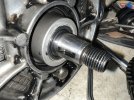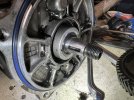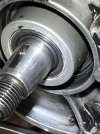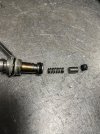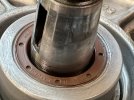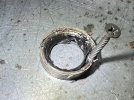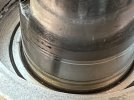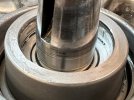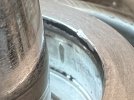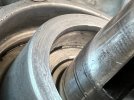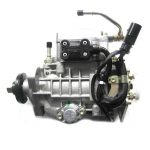Hi all,
I have a 7/1997, first month of drive by wire, L400 with 270k km.
Ever since importing in 7/2022 it had symptoms that sounded similar but not the exact same as other people talking about injection pump seals.
The rough running and blow blue smoke before warmup was the same, but also seemed to be related to the glow plug duty, when the glow plugs ran it was not an issue.
Starting was easier when outside temps were below 50, but summer outside temps 80+ would mean extended cranking and rough running after start, reviving the engine after a start would clear the rough running longer than letting it idle(kinda like if there was some air buildup)
I replaced the filter head with a brand new one with a brand new filter, and replaced the engine bay feed and return lines with double clamps to ensure no leaks or air ingress. No change in symptoms.
Replaced injectors thinking I might have one leaking a little making it such that I had longer cranking due to needing to reprime the system a bit. New aftermarket injectors from Amazon had no change in symptoms.
Added an inline diesel electric lift pump to test the “priming” theory, with the pump running and pre filling/pressurizing prior to start the startup behavior was the same.
Then some cold weather hit thanksgiving week 2023, tried to start the van in 0F temps and couldn’t get it to start. A year prior it would start in similar temps at 11,000 with some protestation. And yes glow plugs are working/verified, and even now replaced with new brand name plugs.
After temps warmed up and battery recharged I got to messing with the van again and determined that a small shot of starter fluid would allow the van to start and run on that, and if I held the pedal down could keep the vehicle running, but just barely and never above idle. I did this long enough to idle and get the van to operation temp, and even with a fully warmed engine I could not restart or keep running without stater fluid and 100% pedal.
Cracking an injector line lead to nothing coming out during cranking, and full gas pedal seemed to make no difference, basically not getting fuel despite fuel demand in place.
Drive by wire gas pedal reports reading 0-100% driver input correctly via OBDII, so it’s at least not a failure of throttle position sensing.
Decided my symptoms were similar enough to those reported by people doing reseals to purchase a reseal kit from Mitsybitz.
Finally warmer weather and more daylight after work meant I was able to get the pump pulled.
First thing I noted when I got it off, the nut on the shaft had been off before, you could see minor deformations from a socket being used on it in a not ideal interface. So it seems to have been worked on before.
With the gear off a visual inspection of the seal shows no obvious external defects(ya that doesn’t necessarily mean anything, but if you ever had a bad oil leak around a cam or crank seal you feel vindicated when you get a pulley or flywheel off and see some big ol chunks missing from a seal, or an obvious mass migration of oil from where it should be to where it shouldn’t be). The seal also looks like some RTV was used around the outside area to help sealing.
In short, it seems like the seal has been replaced, doesn’t look obviously bad, so now I’m questioning what else might warrant attention when I have this pump out. I don’t really want to toss in just a couple of seals and then go through a decent commitment of effort to install just to hope and pray it’s fixed.
So, what else to check out at this point?
I have a 7/1997, first month of drive by wire, L400 with 270k km.
Ever since importing in 7/2022 it had symptoms that sounded similar but not the exact same as other people talking about injection pump seals.
The rough running and blow blue smoke before warmup was the same, but also seemed to be related to the glow plug duty, when the glow plugs ran it was not an issue.
Starting was easier when outside temps were below 50, but summer outside temps 80+ would mean extended cranking and rough running after start, reviving the engine after a start would clear the rough running longer than letting it idle(kinda like if there was some air buildup)
I replaced the filter head with a brand new one with a brand new filter, and replaced the engine bay feed and return lines with double clamps to ensure no leaks or air ingress. No change in symptoms.
Replaced injectors thinking I might have one leaking a little making it such that I had longer cranking due to needing to reprime the system a bit. New aftermarket injectors from Amazon had no change in symptoms.
Added an inline diesel electric lift pump to test the “priming” theory, with the pump running and pre filling/pressurizing prior to start the startup behavior was the same.
Then some cold weather hit thanksgiving week 2023, tried to start the van in 0F temps and couldn’t get it to start. A year prior it would start in similar temps at 11,000 with some protestation. And yes glow plugs are working/verified, and even now replaced with new brand name plugs.
After temps warmed up and battery recharged I got to messing with the van again and determined that a small shot of starter fluid would allow the van to start and run on that, and if I held the pedal down could keep the vehicle running, but just barely and never above idle. I did this long enough to idle and get the van to operation temp, and even with a fully warmed engine I could not restart or keep running without stater fluid and 100% pedal.
Cracking an injector line lead to nothing coming out during cranking, and full gas pedal seemed to make no difference, basically not getting fuel despite fuel demand in place.
Drive by wire gas pedal reports reading 0-100% driver input correctly via OBDII, so it’s at least not a failure of throttle position sensing.
Decided my symptoms were similar enough to those reported by people doing reseals to purchase a reseal kit from Mitsybitz.
Finally warmer weather and more daylight after work meant I was able to get the pump pulled.
First thing I noted when I got it off, the nut on the shaft had been off before, you could see minor deformations from a socket being used on it in a not ideal interface. So it seems to have been worked on before.
With the gear off a visual inspection of the seal shows no obvious external defects(ya that doesn’t necessarily mean anything, but if you ever had a bad oil leak around a cam or crank seal you feel vindicated when you get a pulley or flywheel off and see some big ol chunks missing from a seal, or an obvious mass migration of oil from where it should be to where it shouldn’t be). The seal also looks like some RTV was used around the outside area to help sealing.
In short, it seems like the seal has been replaced, doesn’t look obviously bad, so now I’m questioning what else might warrant attention when I have this pump out. I don’t really want to toss in just a couple of seals and then go through a decent commitment of effort to install just to hope and pray it’s fixed.
So, what else to check out at this point?

